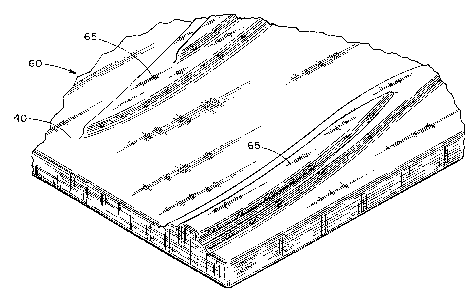Some of the information on this Web page has been provided by external sources. The Government of Canada is not responsible for the accuracy, reliability or currency of the information supplied by external sources. Users wishing to rely upon this information should consult directly with the source of the information. Content provided by external sources is not subject to official languages, privacy and accessibility requirements.
Any discrepancies in the text and image of the Claims and Abstract are due to differing posting times. Text of the Claims and Abstract are posted:
| (12) Patent: | (11) CA 2818123 |
|---|---|
| (54) English Title: | METHOD FOR MAKING ACOUSTICAL PANELS WITH A THREE-DIMENSIONAL SURFACE |
| (54) French Title: | PROCEDE DE FABRICATION DE PANNEAUX ACOUSTIQUES A SURFACE TRIDIMENSIONNELLE |
| Status: | Granted and Issued |
| (51) International Patent Classification (IPC): |
|
|---|---|
| (72) Inventors : |
|
| (73) Owners : |
|
| (71) Applicants : |
|
| (74) Agent: | BORDEN LADNER GERVAIS LLP |
| (74) Associate agent: | |
| (45) Issued: | 2016-09-13 |
| (22) Filed Date: | 2013-06-06 |
| (41) Open to Public Inspection: | 2014-12-06 |
| Examination requested: | 2015-06-12 |
| Availability of licence: | N/A |
| Dedicated to the Public: | N/A |
| (25) Language of filing: | English |
| Patent Cooperation Treaty (PCT): | No |
|---|
| (30) Application Priority Data: | None |
|---|
A method for producing acoustical panels with a three-dimensional surface by bonding stacks of design pieces (21-28) to a flat panel (10). A layer of adhesive (30) is applied over the assembly, and then a fabric layer (40) is applied over the assembly to bond the fabric (40) over the panel (10) and design pieces (21- 28).
Un procédé permettant de produire des panneaux acoustiques avec une surface tridimensionnelle par collage de piles déléments de conception (21-28) sur un panneau plat (10). Une couche dadhésif (30) est appliquée sur lensemble, puis une couche de tissu (40) est appliquée par-dessus lensemble pour coller le tissu (40) sur le panneau (10) et les éléments de conception (21- 28).
Note: Claims are shown in the official language in which they were submitted.
Note: Descriptions are shown in the official language in which they were submitted.

2024-08-01:As part of the Next Generation Patents (NGP) transition, the Canadian Patents Database (CPD) now contains a more detailed Event History, which replicates the Event Log of our new back-office solution.
Please note that "Inactive:" events refers to events no longer in use in our new back-office solution.
For a clearer understanding of the status of the application/patent presented on this page, the site Disclaimer , as well as the definitions for Patent , Event History , Maintenance Fee and Payment History should be consulted.
| Description | Date |
|---|---|
| Inactive: COVID 19 - Deadline extended | 2020-05-28 |
| Common Representative Appointed | 2019-10-30 |
| Common Representative Appointed | 2019-10-30 |
| Grant by Issuance | 2016-09-13 |
| Inactive: Cover page published | 2016-09-12 |
| Inactive: Final fee received | 2016-07-18 |
| Pre-grant | 2016-07-18 |
| Notice of Allowance is Issued | 2016-04-22 |
| Letter Sent | 2016-04-22 |
| Notice of Allowance is Issued | 2016-04-22 |
| Inactive: Q2 passed | 2016-04-20 |
| Inactive: Approved for allowance (AFA) | 2016-04-20 |
| Amendment Received - Voluntary Amendment | 2015-07-20 |
| Letter Sent | 2015-07-09 |
| Request for Examination Requirements Determined Compliant | 2015-06-12 |
| All Requirements for Examination Determined Compliant | 2015-06-12 |
| Request for Examination Received | 2015-06-12 |
| Inactive: Cover page published | 2014-12-15 |
| Application Published (Open to Public Inspection) | 2014-12-06 |
| Inactive: IPC assigned | 2013-09-12 |
| Inactive: First IPC assigned | 2013-09-12 |
| Inactive: IPC assigned | 2013-09-04 |
| Inactive: IPC assigned | 2013-08-26 |
| Inactive: First IPC assigned | 2013-08-26 |
| Inactive: IPC assigned | 2013-08-26 |
| Inactive: IPC assigned | 2013-08-26 |
| Inactive: Filing certificate - No RFE (English) | 2013-06-19 |
| Application Received - Regular National | 2013-06-19 |
There is no abandonment history.
The last payment was received on 2016-05-10
Note : If the full payment has not been received on or before the date indicated, a further fee may be required which may be one of the following
Patent fees are adjusted on the 1st of January every year. The amounts above are the current amounts if received by December 31 of the current year.
Please refer to the CIPO
Patent Fees
web page to see all current fee amounts.
| Fee Type | Anniversary Year | Due Date | Paid Date |
|---|---|---|---|
| Application fee - standard | 2013-06-06 | ||
| MF (application, 2nd anniv.) - standard | 02 | 2015-06-08 | 2015-05-27 |
| Request for examination - standard | 2015-06-12 | ||
| MF (application, 3rd anniv.) - standard | 03 | 2016-06-06 | 2016-05-10 |
| Final fee - standard | 2016-07-18 | ||
| MF (patent, 4th anniv.) - standard | 2017-06-06 | 2017-06-05 | |
| MF (patent, 5th anniv.) - standard | 2018-06-06 | 2018-06-04 | |
| MF (patent, 6th anniv.) - standard | 2019-06-06 | 2019-05-31 | |
| MF (patent, 7th anniv.) - standard | 2020-06-08 | 2020-05-29 | |
| MF (patent, 8th anniv.) - standard | 2021-06-07 | 2021-05-28 | |
| MF (patent, 9th anniv.) - standard | 2022-06-06 | 2022-05-27 | |
| MF (patent, 10th anniv.) - standard | 2023-06-06 | 2023-06-02 | |
| MF (patent, 11th anniv.) - standard | 2024-06-06 | 2024-05-31 |
Note: Records showing the ownership history in alphabetical order.
| Current Owners on Record |
|---|
| JACQUE S. HARRISON |
| DONALD W. HARRISON |
| Past Owners on Record |
|---|
| None |